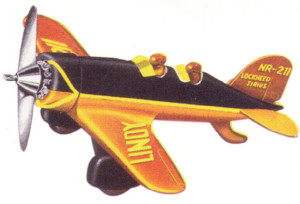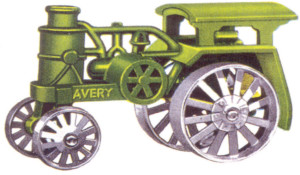From coal dump trucks to cap pistols the toys of Hubley Manufacturing Co. were an historic part of the 20th century.
Their colorful catalogs assured, “Hubley toys are made to sell.” And sell they did. The Lancaster, Pennsylvania enterprise was at one point among the largest makers of cast iron toys in the world.
At Hubley the emphasis was on brightly colored and detailed toys with what they called “play” features. Moreover their rugged and durable line was remarkably varied. Their 1933 catalog, for example, despite the Great Depression offered hundreds of choices from the Avery tractor to the Lindy airplane.
Bank teller John Hubley launched the company late in the 19th century after first making toys for his own children. Early pieces included everything from toy versions of various horse-drawn carriages to the clock movement Elevated Railway.
 While some Hubley toys of that era were motionless, lots of others were steam powered or electric power. Some were amazingly “motorized” with simple key wind springs.
While some Hubley toys of that era were motionless, lots of others were steam powered or electric power. Some were amazingly “motorized” with simple key wind springs.
Hubley himself died in the early 1900s but the company continued to produce a vast assortment of toy treasures which came to include circus wagons, still banks, trains, Ferris wheels, and miniature stoves for dollhouses.
By the 1920s one of Hubley’s most appealing toy offerings was the horse-drawn wagons of the Roy Circus. Writing in The Story of American Toys author Richard O’Brien notes of the Roy Circus, “They were beautifully done, with much decorative detail, and included such esoterica as bandwagons, calliopes, monkey trapeze, mirror van, and more.”
A crowning achievement by Hubley followed the crowning achievement by Charles Lindbergh in 1927. Lindbergh shocked the world with his solo airplane flight from New York to Paris. Hubley had a cast iron version of Lindbergh’s Spirit of St. Louis the following year. The copyrighted and clearly marked Lindy was a big hit for Hubley. Later they included the Lindy Lockheed-Sirius and the Lindy Glider in their winged lineup.
The Hubley company continued to roll during the 1930s with a grand array of toys. Mainstays continued to. be automobiles, trucks and motorcycles. Many of them were “motorized” with key-wind springs and thus propelled the toy vehicles for some distance. Among the wind-up sections were two sizes of dump trucks, racers, road rollers, and a van.
Hubley was also a pioneer in the relatively widespread incorporation of name brands into solid toys. In many cases the company obtained exclusive rights to reproduce the brands thus giving them an added emphasis in the marketplace. Brands appearing on Hubley toys during that era include Borden’s Milk, Bell Telephone, Old Dutch Cleanser, Maytag washer, G.B. refrigerator, Huber Road Roller, Ingersoll-Rand Compressor, Harley-Davidson motorcycle, Eagle ranges, and U.S. Mail.
The nimble firm also ventured into the comic strip world of Popeye too. The Popeye Spinach Patrol featured the sailor on a cast iron motorcycle. Additionally there was a full range of so-called midget line Hubley vehicles. From boat to zeppelin they were similar to the full-sized models but about four to five inches in length.
“One way of staying in business during the Depression was to make everything you could think of that might sell and then hold your breath,” observes O’Brien.
Automated banks produced by Hubley in that decade included the trick elephant bank, the trick dog, and the trick monkey. Still banks featured appliances, bears, lions, dogs, Indians, elephants, and even a copyrighted Fido dog bank.
As 1940 rolled around the Hubley firm had emerged from its humble beginnings to become a world leader in toy manufacturing. Success not withstanding, the company gradually began shifting from cast iron to die-cast zinc. Heavy metals, more expensive to shift, were also increasingly in short supply. Some toys, like the Texan cap pistol, bore both cast iron and zinc parts. Ultimately all zinc materials were used.
Like most other American toy makers, Hubley switch to military devices during World War II. Full toy production resumed in 1946.
Early in the 1950s Hubley underwent still another material transition-this time from zinc metal to mostly plastic. Again, some toys were made with parts of both materials.
Their dandy Frontier Rifle had a metal barrel and magazine but a plastic stock. In 1952 it retailed for $3.98. The early 1950s version ofthe Hubley hook and ladder truck had a metal chassis but a plastic cab and trailer. The ‘modem’ Bell telephone truck was nearly all metal with aluminum trim, but the Motor Express Truck was nearly all plastic except for metal springs and axe is.
A big seller for Hubley starting in the 1950s and continuing well into the next decade was their aircraft with folding. Basically crafted of die-cast metal with sliding plastic canopy and retractable landing gear, they packaged in brightly colored boxes. Each was clearly marked, “A Hubley Metal Toy.”
The storied Hubley company was acquired by Gabriel Industries in 1965. A mixture of die-cast and plastic toys were produced. However the new emphasis was on hobby kits. Boxed and Hubley branded kits included the Model A Roadster and the Model A Station Wagon.
Late in the 1970s Gabriel Industries including the Hubley brand became a division of CBS. However the glory days of Hubley’s magnificent toys would remain in the past.
Captions:
1. Avery toy tractor by Hubley. Cast iron, ca. 1930s, five inches.
2. Lindy Lockheed-Sirius toy airplane. Made by Hubley, ca. 1930s, 10.5 inches long.
3. Truck-Mixer from the 1930s. Cast iron toy made by Hubley Co.
















Follow Us